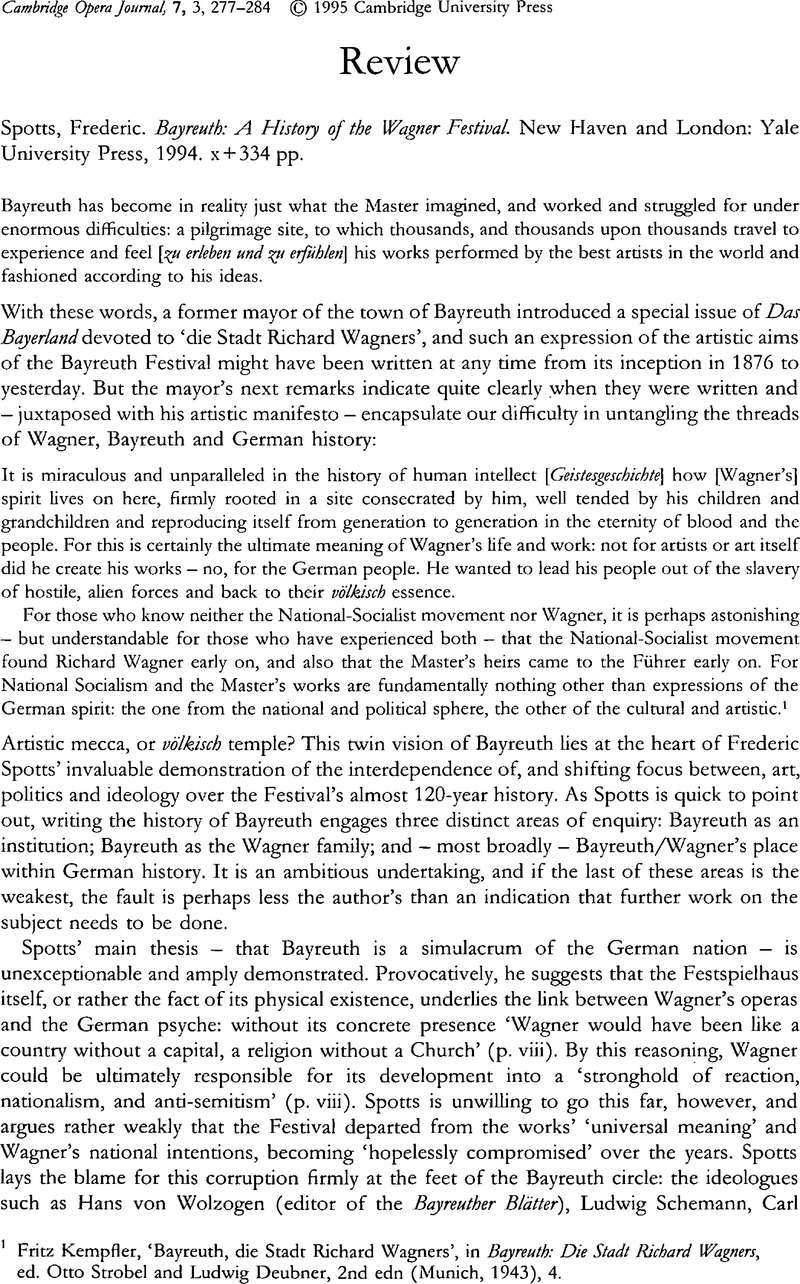No CrossRef data available.
Published online by Cambridge University Press: 27 August 2008

1 Kempfler, Fritz, ‘Bayreuth, die Stadt Richard Wagners’, in Bayreuth: Die Stadt Richard Wagners, ed. Strobel, Otto and Deubner, Ludwig, 2nd edn (Munich, 1943), 4.Google Scholar
2 Wagner, Siegfried, ‘Bayreuth’, Die Musik, 22 (May 1930), 577.Google Scholar
3 For earlier treatments, see Mayer, Hans, Richard Wagner in Bayreuth 1876–1976, trans. Zipes, Jack (New York, 1976);Google ScholarBauer, Oswald Georg, Richard Wagner. The Stage Designs and Productions from the Premières to the Present (New York, 1983); andGoogle ScholarWagner in Performance, ed. Millington, Barry and Spencer, Stewart (New Haven and London, 1992).Google Scholar
4 For Wolfgang Wagner's side of the story, see his Acts: The Autobiography of Wolfgang Wagner, trans. Brownjohn, John (London, 1994).Google Scholar
5 Indeed, since the publication of Spotts’ book, a polemical essay by Nike Wagner calling for Bayreuth to enact a ‘performance pause … for reflection and regeneration, time for recapitulation and for a new departure that would be really thought through’, has appeared. Nike Wagner, ‘Bayreuth––?’, Musical Quarterly, 78 (Spring 1994), 159–70, here 163.Google Scholar
6 SeePachl, Peter P., Siegfried Wagner: Genie im Schatten (Munich, 1988), 89–90, 98, 115, 164–6, 250–1, 281, 314, 393; and Michael Karbaum, Studien zur Geschichte der Bayreuther Festspiele (1876–1976) (Regensburg, 1976), 1/40. A letter from GroB to Adolf Zinsstag, published in Pachl, 393, includes the line: ‘I was not really in the picture, but I received the awful confirmation anyway that the rumours and whisperings about S.W.'s abnormal sex life had their basis’.Google Scholar
7 For several years Wagner blocked publication of Michael Karbaum's Studien zyr Geschichte der Bayreuther Festspiek (see n. 6). He obstructed Peter Pachl's research for his biography of Siegfried Wagner to such an extent that Pachl dedicated the finished work to him with the comment: ‘to Wolfgang Wagner, who by his oppositional attitude first led me on the right way’.Google Scholar
8 For every ‘Rasse und sittliche Forderung’ (Fritz Friedrich, Bayreuther Blätter, 32 [1909], 147–51) there is a ‘Nibelungenlied in Richard Wagners Ringdichtung’ (Friedrich Behn, Bayreuther Blätter, 33 [1910], 44–53). There are articles on aesthetics – Hausegger's Die Musik als Ausdruck was first published serially in the journal in 1884 – philosophy, and about the works of other musicians – Siegfried Wagner in particular.Google Scholar
9 For example,Strobel, Otto, ‘Briefe einer Mutter: Johanna Geyer an ihren Sohn Richard Wagner’, Bayreuther Festspielfuhrer (1933), 15–23.Google Scholar
10 , Strobel, ‘Die Originalhandschrift von Wagners groBer Autobiographic “Mein Leben” ‘, Bayreuther Festspielfuhrer (1933), 30–9.Google Scholar
11 In the same issue of 1933, see Gustav Röll, ‘Die Entwicklung der Richard-Wagner-Gedenkstatte in Bayreuth’, 59–65, and Adolf Zinsstag, ‘Tribschen als Wagner-Museum’, 66–72.Google Scholar
12 For example, see Alfred Lorenz, ‘Der musikalische Aufbau von Richard Wagners “Parsifal” ‘ (1933), 161–8; Karl Grunsky, ‘Zur Rhythmik im “Ring des Nibelungen” ‘ (1933), 142–7; Otto Strobel, ‘ “Morgenlich leuchtend in rosigem Schein”: Wie Walthers “Preislied” entstand’ (1933), 148–53.Google ScholarA complete list of Lorenz's contributions to the Bayreuther Festspielfuhrer may be found in my ‘Alfred Lorenz as Theorist and Analyst’ (Ph.D. diss., University of Western Ontario, 1994), 343–7.Google Scholar
13 Strobel himself is an instructive example of the problem of separating the personal and the political in pre- and postwar Germany. Although he joined the Nazi party on 1 December 1931 (Pg. 771 464) and directed the Forschungsstätte, he nevertheless maintained his position in the family archive after the war and was given a glowing obituary by Oscar von Pander in the Richard-Wagner-Festspiele Presse- und Informationsdienst No. 4 (1953). Despite his political leanings, his immense work in the Wagner archive (both internally and through publications) laid the foundation for all subsequent research, especially for the invaluable Wagner- Werk- Verzeichnis. In fact, the scholarly commitment and intellectual honesty attested to in his uncensored publication of primary source material that reflected badly on Wagner earned him the enmity of Eva Chamberlain, who ensured in her will that certain primary materials in her care (most notably, Cosima's diaries) would not be made public until Strobel was dead.Google ScholarSee Skelton, Geoffrey, introduction to Cosima Wagner's Diaries (New York, 1978), I, 18–21.Google Scholar